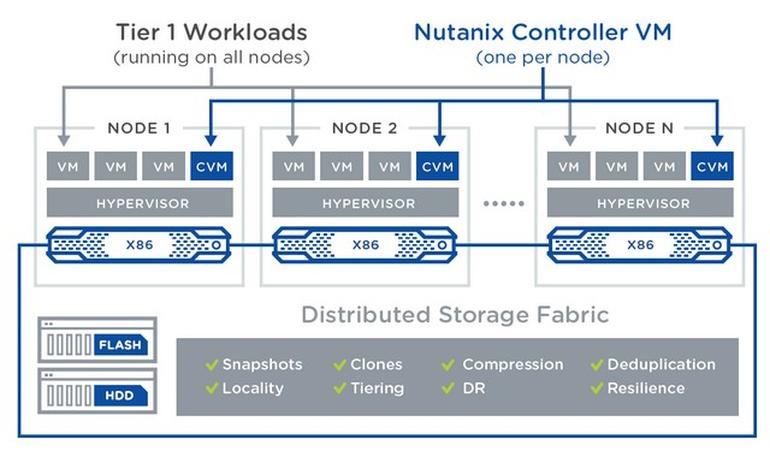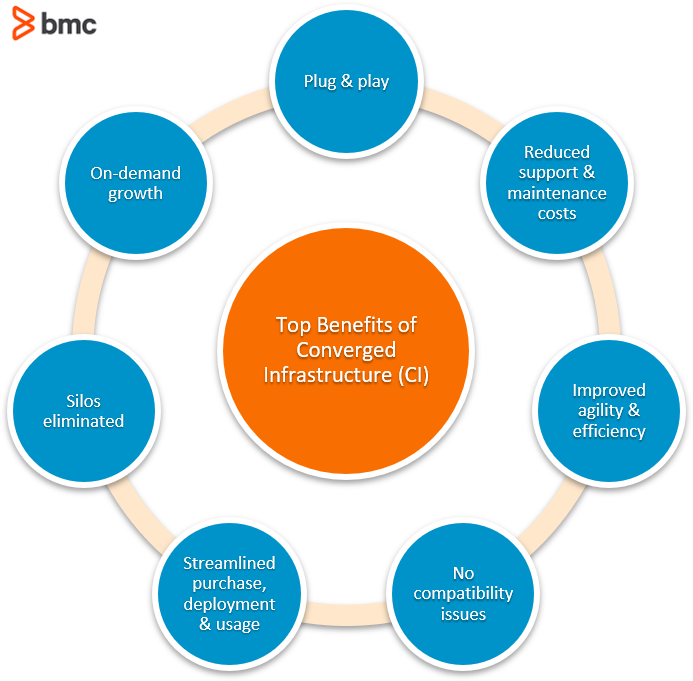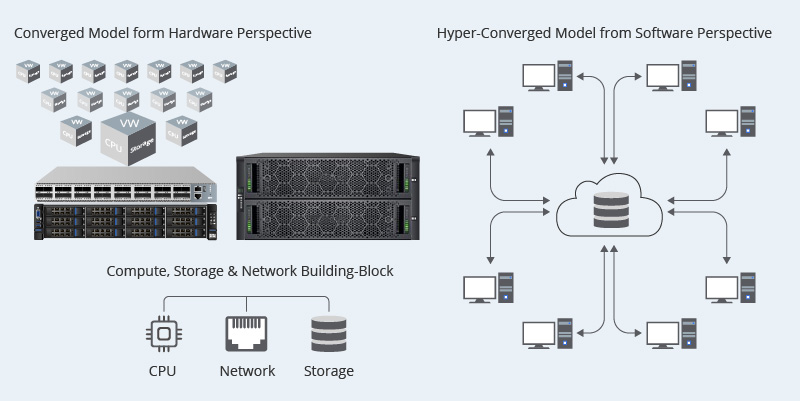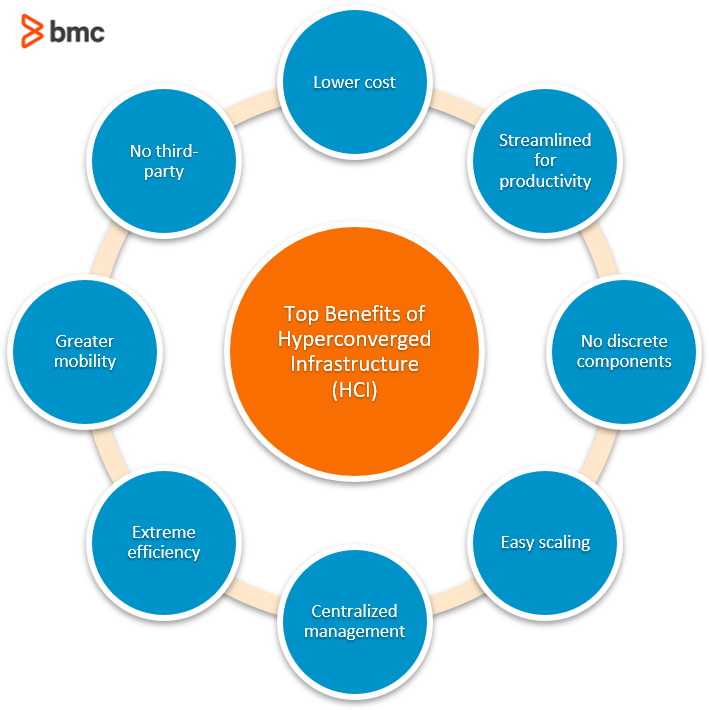Today’s businesses want IT to have fewer moving parts—while still offering the same or expanded resources to users. This demand has resulted in a shift:
- Away from a one-to-one relationship between physical servers and storage
- Towards a many-to-one relationship between virtual machines and a single-storage controller
One major complication with virtualizing workloads, though, is that it increases storage capacity requirements, often resulting in an enormous volume of redundant data. This results in wasted time, wasted effort, and wasted work hours.
Fortunately, converged infrastructure (CI) solves these problems. By combining workloads, you streamline processes and make your business perform better.
As CI evolves, hyperconverged infrastructure (HCI) is the natural next step. HCI is growing in popularity, with an estimated increase in CAGR at 22% from 2019-2023. Professionals in IT often see HCI as the best chance for organizations to becoming more like the cloud—that is, delivering IT as a service.
So, how do you know if converged and hyperconverged infrastructures are right for you? In this article, we’ll look at:
- Non-converged architecture
- Converged infrastructure
- Benefits of CI
- CI vs HCI
- HCI
- Benefits of HCI
- When to use
- How to implement
- Additional resources
Brief summary: CI vs HCI
Short on time? Here’s a quick definition of the key terms:
- Converged Infrastructure (CI) is a hardware-based approach to converging storage and processes that reduces compatibility issues, complex deployments, and overall costs. It works by using building blocks.
- Hyperconverged Infrastructure (HCI) is a software-based approach to converging storage and processes. This usually means deployment on commodity components. Importantly, the term ‘hyperconverged’ here does not imply that this technology is superior to regular converged infrastructures.

Converged infrastructures reduce the need for large, physical setups, allowing you to converge and optimize multiple systems at once.
How non-converged architecture works
Before we dive deeper, let’s look at a non-converged architecture.
In a non-converged architecture, physical servers operate a virtualization hypervisor that manages each of the virtual machines (VMs) that have been created on the server. For data storage, there are typically three options:
- A storage-area network (SAN)
- Direct-attached storage (DAS)
- Network-attached storage (NAS)
With converged architecture, storage is attached directly to the physical server. Regular converged architecture can be just as fast (if not faster) than hyperconverged alternatives. In this setup, flash storage is almost always used. (The need for expensive SAN and NAS, in particular, is eliminated.)
Hyperconverged infrastructure has a storage controller function that runs as a service on every node in the cluster, which is why this is classified as software-defined storage. Most commonly, important data that you need to access quickly is kept local (hot storage) while less crucial data is stored on the actual servers (warm or cold storage).
(Learn more about software-defined data centers, or SDDCs.)
Now, let’s look at CI and HCI in more detail.
What is converged infrastructure (CI)?
Converged infrastructure is an approach to data center management that aims to minimize compatibility issues between storage systems, servers, and network devices. A secondary aim of CI is to reduce costs that are associated with physical components including everything from floor space and cooling to power and cabling.
CI combines storage and compute into a single physical appliance that is small, dynamic, and powerful. This approach brings many benefits:
- Lower deployment costs
- Simplified management
- Reduced maintenance and support costs
For a clearer understanding of CI, let’s see how the differences in converged storage and unified architecture play out in converged infrastructure.
Converged storage
Traditional storage typically involves:
- A controller
- A rack of shelves with SSD or HDD arrays
Converged storage consolidates these components into a node-based storage platform that offers exceptional redundancy. Everything is included in a single box, and you can scale simply by adding more nodes when needed.
Converged storage solutions are available in a wide range of sizes, and they may be all flash or hybrid arrays.
This option makes sense for any organization that already has a network and compute platform but intends to deploy different types of storage for sets or virtual machines.
Rather than adding a new shelf, as in traditional storage, you offload the workload to a converged storage system. This ensures that there is a viable data storage solution for the foreseeable future. There are many advantages to this solution, including:
- Better integration
- Easier management
- Lower costs
Unified architecture
In a typical unified architecture, the compute, network, and storage components remain separate. However, a fabric backplane directly connects them, which cuts down on bandwidth contention.

The use of nodes is clear in Nutanix’s Acropolis hypervisor. (Source)
This option makes sense for organizations that deploy data center platforms that use the same vendor across multiple hardware technologies. It also enhances security considerably.
Unified architecture tends to be fairly pricey, which can be a stumbling block for organizations wanting to gain the benefits of a converged infrastructure.
Convergent infrastructure
Now we can see how CI combines compute and storage into a single physical appliance. Storage management in CI systems is processed as an application. This results in a converged, unified platform.
Networking is important to an extent, and it’s typically accomplished via the hypervisor, which means that no actual pieces of networking hardware are needed. Unlike virtual architecture, CI is almost always made up of just storage and compute.
This approach means you can integrate abstract services and hypervisor technologies with underlying physical architecture. There are many advantages to this approach:
- Save time on deployment
- Reduce deployment costs
- Simplify overall management through the unification of data center controls
Converged infrastructure benefits
When the top advantages of CI are considered, it is easy to see why so many organizations are adopting this technology. A few of the most compelling benefits of CI include:

- Plug & play solution. CI is basically a plug-and-play solution. It is made up of standalone components that can be decoupled from the infrastructure and used separately. Individual blocks can be snapped together. Doing things this way is almost always cheaper than the a la carte route.
- Reduced support & maintenance costs. Because CI reduces redundancy so well, maintenance and support costs are dramatically reduced. IT specialists don’t have as many repetitive tasks to perform to keep the system up and running. This saves the organization a lot of money, especially when deploying new parts in the infrastructure.
- Improved agility & efficiency. With CI, IT components are consolidated into a single, optimized platform with centralized management. This improves both agility and efficiency. It also helps to reduce costs due to increased utilization.
- Compatibility issues eliminated. Because everything is supplied by a single vendor or a vendor and its partners, compatibility issues are handily eliminated. This is yet another way CI helps to keep costs in check and streamline the management of data centers.
- Streamlined purchasing, deployment & use. Since all components are housed in a single box, purchasing, deploying, and using CI is incredibly streamlined when compared with traditional, non-converged architectural environments.
- Eliminate silos. CI eliminates silos of technology, processes, and people. Silos are largely why traditional data center management has been convoluted and difficult. CI is a big step towards simplicity and ease of management.
- On-demand growth model. CI allows organizations to design, build, and maintain specific segments of a virtualization stack while supporting an on-demand growth model.
For any business, the ability to quickly and effortlessly build upon data center needs cannot be understated.
CI vs HCI: Converged infrastructure evolves
In the world of data center management, CI was a breakthrough. Still, it is constantly evolving and being improved upon.
The next generation of CI pulls together compute, SAN, and storage functionality into modular appliances that are based on commodity x86 hardware. This hardware can be scaled out by adding additional appliance nodes.
As a single-vendor solution, CI:
- Dramatically reduces acquisition costs
- Streamlines deployment
This brings us to the next generation—hyperconverged infrastructure. HCI offers, by far, the best value for a very simple reason: design, delivery, and support are all handled by a single vendor.
The easiest way to distinguish CI from HCI?
- Converged architecture takes a hardware-focused, building-block approach.
- Hyperconverged architecture is software-defined.

CI approach vs HCI approach. (Source)
CI consists of building blocks. Each of the components in one of these building blocks is discrete and can be used on its own for its intended purpose. In other words, for instance, the server can be separated and used strictly as a server.
With HCI, the technology is software-defined. All of the technology is completely integrated, which means that it cannot be broken down into separate components.
What is hyperconverged infrastructure (HCI)?
Also known as ultra-converged infrastructure, hyperconverged infrastructure is widely regarded as the future of data center design. In this approach, software controls all of the resources that are atop the hypervisor.
This software perspective approach has allowed for new data center concepts. HCI systems can be deployed on any kind of hypervisor or any piece of hardware through:
- Virtual machine translation technologies
- APIs
You can create your own CI platform by deploying overlying software that allows you to manage compute and storage. As a bonus, if a second location is running a different hypervisor, convergence software is capable of translating virtual machines from one hypervisor to the other—you only need to meet the underlying hardware requirements.
Through APIs, an organization can:
- Integrate further with public cloud components
- Extend your data center beyond private architecture
- Integrate with other hypervisors
From there, you can integrate orchestration and automation controls across platforms to achieve a next-generation cloud and data center model. No wonder HCI is gaining popularity!

Benefits of hyperconverged infrastructure
To understand the technology more fully, let’s look at the many advantages of HCI:
- Lower cost. Reduced operational expenses (and TCO) also reduce or correct interoperability and complexity issues.
- Streamlined productivity. Streamlined acquisition, deployment, support, and management of the solution both reduces costs and increases staff productivity, potentially driving profitability. This streamlining also enables rapid application development, another point towards profit.
- No discrete IT components. Fewer moving parts means that there are fewer opportunities for hardware issues. All IT services and infrastructure are combined below the hypervisor within a single, shared pool of x86 resources.
- Easy scaling. HCI provides a scalable, building-block approach that you can easily expand—just add more units.
- Centralized management. With a single interface, you can centrally manage all virtual environments globally. This cuts down on the amount of work needed to maintain the system, therefore increasing productivity. It also minimizes the risk of over-provisioning and over-purchasing.
- Extreme efficiency. HCI allows for extremely efficient use of resources by saving IOPS, eliminating duplicate services and devices, and offloading intensive processing from x86 processors, ensuring that maximum CPU resources are available at all times.
- Greater mobility. HCI shifts management over to apps and virtual machines, leading to greater mobility.
- No third-party replication and backup. Because of virtual machine level backups and the replication of backup data between sites, HCI eliminates the need for third-party replication and backup software and hardware and third-party backup specialists.
When to use CI & HCI
CI makes sense in many situations but may not be the right option for others. Organizations that are interested in CI should weigh the benefits and costs to gain a clear understanding of what is involved before taking the plunge.
Here’s a few situations where CI could be the ideal fit:
- Deploying new tier-one applications or when virtualizing applications
- Managing remote or branch office (ROBO) infrastructure
- Managing remote disaster recovery sites
- Engaging in data center consolidation, whether within or across data centers
- Implementing virtual desktop infrastructure (VDI)
- Performing data migration within or across sites
- Testing or developing infrastructure
The above list is by no means comprehensive, but it does begin to show the wide range of applications for CI. Importantly, many organizations would benefit even more from HCI.
How to implement CI & HCI
There are a few different ways to implement CI. Here are the most common approaches.
Approach 1: Convergent infrastructure references architecture
With this approach, the vendor supplies the customer with pre-tested recommendations about how to use hardware components in their data center to meet requirements for specific workloads.
Approach 2: IT appliance
With this option, the vendor supplies the customer with a single box that includes a tightly integrated combination of storage, compute, virtualization, and networking resources from the vendor and, in some cases, the vendor’s partners. This approach offers horizontal scalability so additional appliances can be added when needed.
Approach 3: Hyperconvergence
In this scenario, the vendor abstracts networking, compute, and storage resources from the physical hardware. Virtualization software is bundled with their CI offerings.
In many instances, the vendor also provides additional functionality for disaster recovery and cloud bursting. This allows the admins to manage the virtual and physical infrastructure in a federated manner via a single pane of glass.
The future of converged infrastructure
The technologies powering both CI and HCI continue to evolve and improve. Without a doubt, a new or improved generation will be available in the not-too-distant future.
Related reading
- BMC IT Operations Blog
- What is Software-Defined IT Operations? SDITO Explained
- Server Consolidation: 6 Steps for Addressing Server Sprawl
- What’s Serverless? Pros, Cons & How Serverless Computing Works
- Introduction To Web Scale IT
See an error or have a suggestion? Please let us know by emailing blogs@bmc.com.






